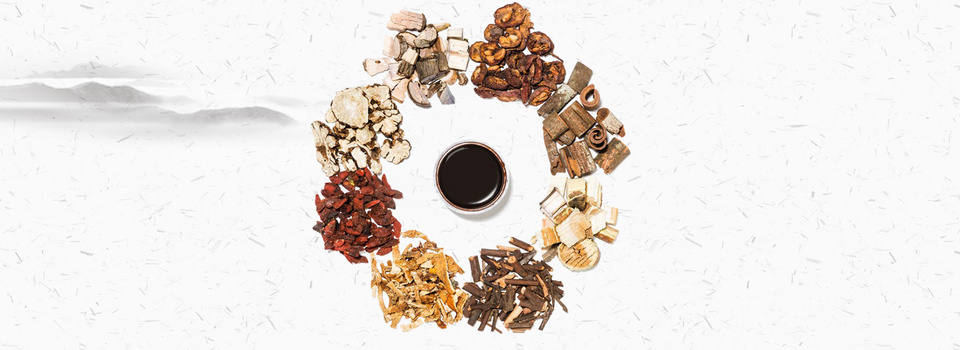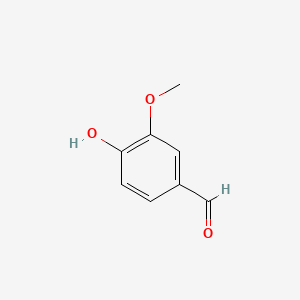4-hydroxy-3-methoxybenzaldehyde, 5-bromovanillin, 5-chlorovanillin, vanillaldehyde, vanillin, vanillin, sodium salt



| Name | Vanillin | ||
| PubChem CID | 1183 | ||
| Molecular Weight | 152.15g/mol | ||
| Synonyms |
4-hydroxy-3-methoxybenzaldehyde, 5-bromovanillin, 5-chlorovanillin, vanillaldehyde, vanillin, vanillin, sodium salt |
||
| Formula | C₈H₈O₃ | ||
| SMILES | COC1=C(C=CC(=C1)C=O)O | ||
| InChI | 1S/C8H8O3/c1-11-8-4-6(5-9)2-3-7(8)10/h2-5,10H,1H3 | ||
| InChIKey | MWOOGOJBHIARFG-UHFFFAOYSA-N | ||
| CAS Number | 121-33-5 | ||
| ChEMBL ID | CHEMBL13883 | ||
| ChEBI ID | CHEBI:18346 | ||
| Herb ID | HBIN047744 | ||
| Drug Bank ID | DB10576 | ||
| KEGG ID | C00755 | ||
| Toxicity | Organism | Test Type | Route(Dose) |
| rat | LD50 | intraperitoneal(165 mg/kg) | |
| mouse | LD50 | intraperitoneal(254 mg/kg) | |
| rat | LD50 | oral(322 mg/kg) | |
| Structure | 
|
Download
2D
MOL
3D
MOL
|
|
| Chineses Pinyin | XiangJiaLan | ||
| Use Part | Whole herb | ||
| Species |
>Kingdom: Viridiplantae
-->Phylum: Streptophyta
-->Class: Equisetopsida
-->Order: Asparagales
-->Family: Orchidaceae
-->Genus: Vanilla
-->Species: Vanilla planifolia
|
||
| Pair Name | Vanillin, Fluorouracil | |||
| Partner Name | Fluorouracil | |||
| Disease Info | [ICD-11: 2B91.Z] | Colorectal cancer | Investigative | |
| Biological Phenomena | Induction-->Apoptosis | |||
| Gene Regulation | Down-regulation | Expression | NNMT | hsa4837 |
| Up-regulation | Expression | TP53 | hsa7157 | |
| Up-regulation | Cleavage | CASP3 | hsa836 | |
| Up-regulation | Cleavage | CASP9 | hsa842 | |
| Up-regulation | Cleavage | PARP1 | hsa142 | |
| Up-regulation | Phosphorylation | MAPK14 | hsa1432 | |
| Up-regulation | Phosphorylation | MAP3K5 | hsa4217 | |
| In Vitro Model | HT-29 | Colon adenocarcinoma | Homo sapiens (Human) | CVCL_0320 |
| SW480 | Colon adenocarcinoma | Homo sapiens (Human) | CVCL_0546 | |
| In Vivo Model | A total of 3×10⁶ cells from each of the SW480/NC and SW480/NNMT cell lines were subcutaneously injected into nude mice (n=5 per cell line). | |||
| Result | Vanillin is deemed to be a promising anticancer candidate by inhibiting NNMT and may attenuate NNMT‑induced resistance to 5‑Fu in human CRC therapy with few side effects. | |||
| Pair Name | Vanillin, Doxorubicin | |||
| Partner Name | Doxorubicin | |||
| Disease Info | [ICD-11: 2C60] | Breast cancer | Investigative | |
| Biological Phenomena | Induction-->Apoptosis | |||
| Gene Regulation | Up-regulation | Expression | CASP9 | hsa842 |
| Up-regulation | Expression | BAX | hsa581 | |
| Down-regulation | Expression | BCL2 | hsa596 | |
| In Vitro Model | MCF-7 | Invasive breast carcinoma of no special type | Homo sapiens (Human) | CVCL_0031 |
| In Vivo Model | Mice were inoculated with 0.1 ml containing 5×10⁵ viable EAC cells/mice in the right hind limb (thigh) subcutaneously. | |||
| Result | Vanillin can be a potential lead molecule for the development of non-toxic agents for the treatment of breast cancer either alone or combined with DOX. | |||
| No. | Title | Href |
|---|---|---|
| 1 | The synergistic effect between vanillin and doxorubicin in ehrlich ascites carcinoma solid tumor and MCF-7 human breast cancer cell line. Pathol Res Pract. 2016 Sep;212(9):767-77. doi: 10.1016/j.prp.2016.06.004. | Click |
| 2 | Vanillin downregulates NNMT and attenuates NNMT‑related resistance to 5‑fluorouracil via ROS‑induced cell apoptosis in colorectal cancer cells. Oncol Rep. 2021 Jun;45(6):110. doi: 10.3892/or.2021.8061. | Click |
